On-Page SEO for Swimming Pool Companies: The Ultimate Guide to Rank #1 in 2023

- by Kester Browne
Aug 8, 2023
There are more than 10 million swimming pools in the U.S, and in the age of the digital marketing, the competition among swimming pool companies has transitioned from physical showrooms to the online world.
And while having a stellar portfolio of sparkling pools is essential, how you present it online matters as much, if not more.
Enter On-Page SEO for swimming pool companies—a digital game-changer.
It's not just about having a website; it's about optimizing your website to ensure your business surfaces when potential clients dive into search engines looking for their dream pool solutions.
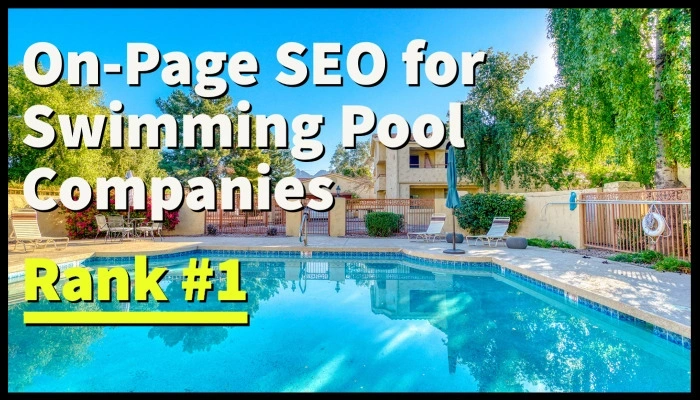
In this comprehensive guide, I'll unravel the intricacies of On-Page SEO, ensuring your swimming pool company doesn't just stay afloat but rides the wave to online success.
Let's dive in.
The Basics of On-Page SEO
What is On-Page SEO?
On-Page SEO is the practice of optimizing individual web pages to rank higher in search engine results and draw in more relevant traffic.
It's unlike off-page SEO, which centers on external signals like backlinks, on-page SEO zeroes in on optimizing a page's content and HTML source code.

Why On-Page SEO is Crucial for Swimming Pool Companies
1. Building Trust and Credibility In an industry where investments are significant and the end product is often a lifelong dream, trust is paramount. On-page SEO elements, such as quality content and authentic testimonials, foster this trust by presenting your company as knowledgeable, experienced, and endorsed by satisfied clients.

2. Visibility in Local Searches Swimming pool companies typically cater to local audiences. Properly optimized on-page elements ensure you show up when potential clients in your area are looking for a pool installation or related services. With location-specific keywords and localized content, you're putting your business directly in front of the people most likely to convert.
3. Staying Ahead of the Competition The swimming pool industry, like many others, is competitive. A well-optimized website is a differentiator. When two companies offer similar quality and pricing, the one that's easier to find online often gets the contract.
4. Increasing Organic Traffic Paid advertising is effective, but it's also costly. Organic traffic, on the other hand, is free. Investing in on-page SEO ensures a steady stream of potential clients without the recurring costs of ads.
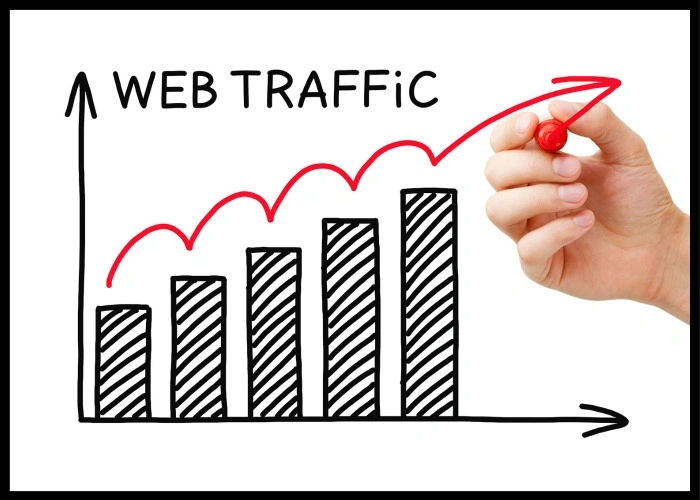
5. Enhancing User Experience - Users love a seamless online experience. Elements of on-page SEO, like mobile optimization and fast page speeds, help in rankings and ensure potential clients navigate your site effortlessly. A satisfied online visitor is more likely to become a happy customer.
6. Conversions and ROI - Good on-page SEO doesn't just increase traffic; it attracts relevant traffic. A user finding precisely what they're looking for on your site is far more likely to take the desired action, whether requesting a quote or booking a consultation. A well-optimized site can outperform most other marketing strategies in terms of return on investment.
7. Demonstrating Expertise - Content remains king in the digital domain. Well-researched, expertly-written articles on pool designs, maintenance tips, and industry trends improve rankings and position your company as an authority in the pool industry.
8. Future-Proofing Your Business - SEO, especially the on-page elements, is ever-evolving. Regularly updating and optimizing your website keeps your business agile and ready to adapt to changes in search engine algorithms or industry trends.
On-page SEO isn't just a tactic; it's a commitment to excellence, visibility, and user experience. It's an invaluable process for pool companies in a digital-first world, ensuring you remain front and center in potential clients' minds (and searches).
Essential On-Page SEO Elements & Best Practices for Swimming Pool Companies
SEO isn't just about the content you produce but how you present it. On-page SEO optimizes individual web pages to ensure they rank higher and earn more relevant traffic. Here's a detailed guide tailored for swimming pool companies.
Title Tags: Your First Impression
What Are Title Tags?
Title tags are the clickable headlines displayed in search engine results. These brief yet potent lines of text are the first thing a potential customer will see when they type a query related to swimming pools.
They provide an initial impression, a promise of the information, products, or services they'll access with just one click.

Why Are They So Important?
- First Impressions Matter: Just as the entrance to a pool determines how inviting it is, a title tag determines if a user will click on your link or move on to another. It sets the stage for the content they're about to engage with.
- SEO Significance: Search engines use title tags to understand the content of a webpage. An aptly chosen title tag can significantly improve your page's ranking, especially when it aligns with a searcher's intent.
Best Practices for Crafting the Perfect Title Tag:
- Be Concise Yet Impactful: It's a delicate balance. Your title tag should stay under 60 characters, but every word must count.
- Keyword Inclusion: Position your primary keyword towards the beginning. For a swimming pool company, these could include "custom pool designs" or "pool maintenance services."
- Stay Relevant: Misleading title tags might get clicks, but they lead to high bounce rates. Ensure your title tag offers a truthful snapshot of your page's content.
- Invoke Curiosity: While being factual, a touch of intrigue or promise of value, like "Top Pool Designs of 2023", can make a user eager to dive into your content.
Meta Descriptions: The Preview for Your Swimming Pool Business
Understanding Meta Descriptions - Meta descriptions are summaries below the title tag in search engine results. While they seem simple, they are vital in determining whether a user will plunge into or skim past your content.

Why You Need Meta Descriptions
- Engage & Attract: Your meta description is your pitch. It's your chance to convince searchers that your content, whether about innovative pool designs or maintenance tips, is worth their time.
- Enhance Click-Through Rates: A compelling meta description can significantly boost your click-through rates. The more clicks you get, the higher the chances of converting those visitors into customers.
Best Practices for Meta Descriptions:
- Stay Succinct: Meta descriptions should be a brief 150-160 characters. Think of it as your elevator pitch; be quick yet compelling.
- Incorporate Keywords: While not a direct ranking factor, including relevant keywords can make your description resonate more with searchers. Phrases like "luxury pool installations" or "eco-friendly pool systems" can pique interest.
- Provide Value: Highlight what makes your content or offerings unique. You could share a guide on sustainable pool heating or showcasing award-winning pool designs.
- End with a Call to Action: Encourage the reader to take the next step. Phrases like "Discover more," "Learn how," or "Dive in" can be pretty effective.
URL Structures: Paving the Clear Pathway to Your Pool Services
The URL of a webpage might appear as just an address, a means to navigate to a particular site. However, for swimming pool companies, a structured URL is the equivalent of the welcoming entrance to a luxurious resort pool — it gives a clear, straightforward pathway, signaling what awaits the visitor.
Decoding URL Structures
A URL (Uniform Resource Locator) is the web address of a page. The line starts with https://' you type into your browser. But beyond this, a well-crafted URL provides cues about the content of the page and its relevance to a searcher's query.
The Significance of URL Structures for Pool Company Websites:
- Improved User Experience: Clear, descriptive URLs let potential customers know exactly what to expect. A URL like "poolcompany.com/custom-infinity-pools" paints a picture even before they click.
- Boosted Search Engine Rankings: Search engines, like users, prefer easy-to-read and understandable URLs. Clean URLs can help your pool-related content rank better.
Best Practices for URL Structures:
- Keep it Short and Descriptive: Lengthy URLs can be off-putting. Stick to the essentials. For instance, instead of "poolcompany.com/blog/2021/may/best-pools," opt for "poolcompany.com/best-pool-builder-sacramento-ca."
- Use Keywords Strategically: Incorporate main keywords naturally. If you're showcasing saltwater pool systems, your URL could be "poolcompany.com/saltwater-pool-systems."
- Avoid Numbers and Special Characters: These can confuse search engines and users. Stick to words and hyphens to separate terms.
- Consistency is Key: Stick to a consistent structure for all URLs on your site. This helps in maintaining a cohesive brand image.
Heading Tags (H1, H2, H3): Structuring Content Like Pool Ladders
Imagine a vast, luxurious swimming pool with multiple depths. Moving from the shallow end to the deep end could be challenging without ladders or steps at intervals. Similarly, on a web page, heading tags, such as H1, H2, and H3, serve as those critical steps, guiding your reader through different sections of your content easily.

Understanding the Role of Heading Tags: Heading tags range from H1 to H6, with H1 being the most important. Think of these tags as the layers or tiers of a content hierarchy.
- H1 Tag: The Primary Subject: Like the main entrance to a pool area, your H1 should encapsulate what the entire page is about. Typically, this is your page's or article's title and should be used once per page.
- H2 Tags: Subtopics or Main Sections: H2 tags break your content into its primary subsections. In the context of a pool company, an H2 might be "Benefits of Saltwater Pools."
- H3 Tags: Further Breakdown: If you need to divide an H2 section further, use H3 tags. For the previous example, under the H2 of "Benefits of Saltwater Pools," an H3 might be "Less Maintenance Required."
Why Swimming Pool Companies Must Use Heading Tags:
- Enhanced User Experience: Properly structured content helps readers skim and locate the information they're most interested in, similar to how pool signs guide visitors to different areas.
- SEO Boost: Search engines use heading tags to understand the structure and relevance of your content. An aptly placed keyword in a heading can elevate its importance in the eyes of search algorithms.
- Mobile-Friendliness: With many users accessing content on mobile devices, clear headings simplify navigating the content on smaller screens.
Best Practices:
- Use Hierarchically: Your main title (often the blog post title or main page header) should be H1. Subsections are H2, sub-subsections H3, and so forth.
- Include Keywords: Incorporate relevant keywords, especially in your H1 and H2s. For instance, if discussing pool safety, headers like "H2: Pool Safety Equipment" or "H3: Childproofing Your Pool" can be both relevant and keyword-rich.
Keyword Optimization: The Pool Water Chemistry of Your Content
Crafting content without keyword optimization is similar to maintaining a swimming pool without monitoring its water chemistry.
Just as pool owners need the right balance of chemicals for clear, inviting water, swimming pool companies need the right blend of keywords to draw traffic and engage readers.

Why Keywords Matter:
Keywords are the terms potential customers type into search engines when looking for services or products. These are your online magnets, drawing visitors to your site.
The Steps to Perfect Keyword Optimization
#1. Research is Your Starting Block:
Before diving into content creation, do keyword research. Tools like Google's Keyword Planner or SEMrush offer insights into what your potential customers are searching for. For a swimming pool company, terms might include "saltwater pool installation," "pool maintenance tips," or "best pool designs 2023."
#2. Natural Inclusion:
While sprinkling keywords generously is tempting, weaving them seamlessly is vital. Forced or excessive use can harm your SEO and turn readers away. Picture it as adding chlorine to a pool: too much can irritate swimmers, and too little won't serve the purpose.
#3. Consider Semantic Keywords:
Search engines are becoming more intelligent, understanding context better than ever. So, alongside your primary keywords, include semantically related terms. If "pool cleaning service" is your primary keyword, related terms might be "pool skimming" or "algae removal."
#4. Location Matters:
Place your primary keywords in strategic positions: the title, headings, and the first 100 words. It's like positioning the main attractions around a pool; you want them where they'll be most noticed.
Best Practices for Keyword Optimization
- Understand User Intent:
- It's not just about the keyword; it's about why someone is using it. Do your customers want to buy a pool, get one serviced, or gather information? Align your content with the searcher's intent.
- Use Long-Tail Keywords:
- While short keywords like "pool services" are essential, longer phrases such as "best pool services near me" or "inground pool installation costs" often have less competition and target users closer to making decisions.
- Avoid Keyword Stuffing:
- Overloading your content with keywords will not only deter readers but could also attract penalties from search engines. Think of it as over-chlorinating a pool; it can cause more harm than good.
- Update Your Keyword List Regularly:
- Trends, services, and customer preferences change. By periodically revisiting and updating your keyword list, you ensure you're still attracting your ideal customers.
- Monitor Keyword Performance:
- Tools like Google Analytics can help you see which keywords are bringing traffic and which aren't. Adjust your strategy based on this data.
- Use Keywords in Image Alt Text:
- If you have images of beautiful pools on your site, ensure the alt text (the text that describes the image for search engines) includes your target keywords.
- Consider Voice Search:
- As voice-activated assistants like Alexa and Google Home become more popular, think about how people might phrase their queries verbally. This often means targeting more natural, conversational phrases.
- Stay Updated on Algorithm Changes:
- Search engines occasionally update their algorithms. Stay informed so you can adjust your strategy accordingly.
Image Optimization: Capturing the True Essence of Your Pools with Pixels
Images play a pivotal role for swimming pool companies. They offer a visual representation of what customers can expect—whether it's the serene ripple of a modern infinity pool or the joyous splash of a family pool. However, optimization is crucial for these images to impact online truly.
Unpacking Image Optimization:
Image optimization revolves around reducing the file size of images without compromising on quality. Additionally, it ensures images are easily discoverable by search engines, helping them understand and rank the content better.
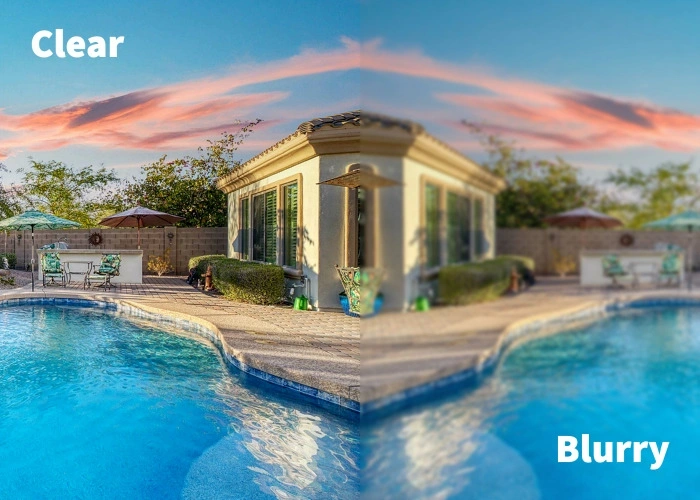
Why Image Optimization Matters for Pool Companies:
- Faster Webpage Load Times: High-resolution pool images can be heavy, slowing down page load times. Optimized images load quickly, providing a seamless experience for potential customers.
- Improved SEO Ranking: Search engines prioritize websites that offer a better user experience. Your site can climb the ranks with faster load times and appropriately tagged images.
- Enhanced Mobile Experience: With many customers browsing on mobile, optimized images ensure they can view your stunning pools without excessive data usage or delays.
Best Practices for Image Optimization:
- Choose the Right File Type: JPEGs are generally best for photos due to their balance of quality and file size. PNGs, on the other hand, are ideal for graphics with transparent backgrounds. Webp is the best format for the web.
- Resize Images: Before uploading, ensure images are of the appropriate size. A full-screen image of a pool doesn't need to be larger than 1920x1080 pixels for most websites.
- Utilize Image Compression Tools: Tools like TinyPNG or Squoosh can help reduce file size without degrading quality.
- Include Alt Text: Alt text describes the content of the image for search engines and for users who might not be able to view it. An alt text like "family enjoying their new in-ground pool" gives context and boosts SEO.
- Adopt Descriptive File Names: Instead of generic names like "image1.jpg," use descriptive ones like "infinity-edge-pool-sunset-view.jpg."
By optimizing your images, you not only enhance the user experience but also increase the chances of your pool designs being showcased to a broader audience online.
Internal & External Linking: Building the Aquatic Network of Your Pool Content
Internal links are hyperlinks that point to another page on the same website.
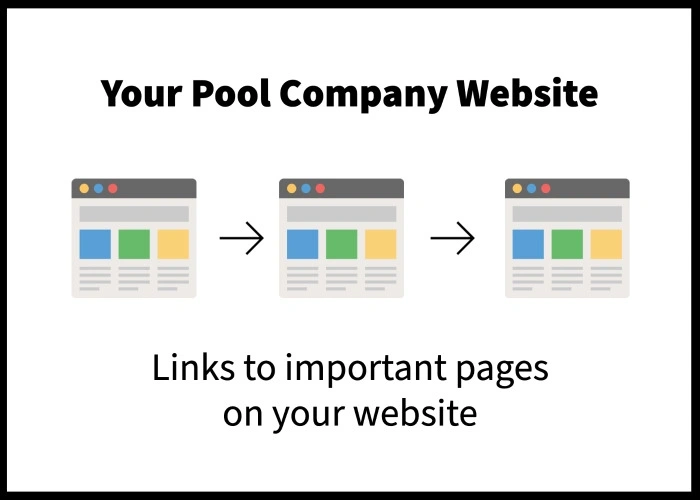
In contrast, external links point to pages on different websites. Both play a pivotal role in SEO and user experience.
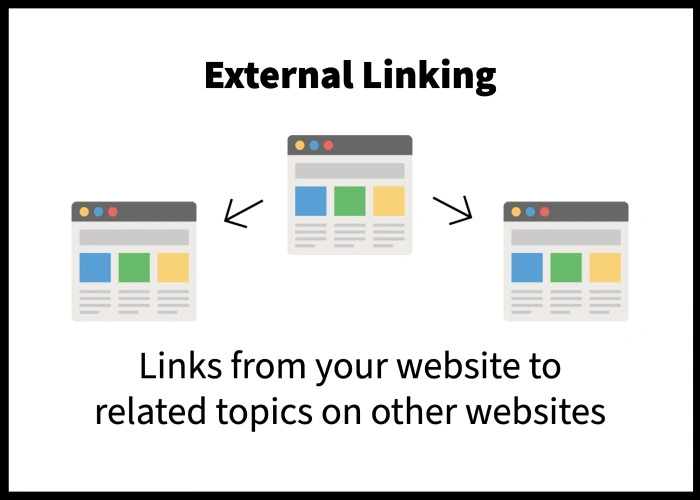
The Role of Linking for Swimming Pool Companies:
- Navigation and User Experience: Internal links aid website navigation, guiding potential customers from general information to specific pool designs or services.
- Website Hierarchy and Page Authority: By linking from high-authority pages to those that need a boost, you distribute "link juice" and establish a hierarchy of importance.
- Enhancing Trust and Authority: External links to reputable sources bolster the credibility of your content, demonstrating thorough research and backing up claims.
Best Practices for Effective Linking:
- Relevance is Key: Ensure that the content you're linking to, internally or externally, is highly relevant to the context. For instance, a page about pool maintenance could link to another on eco-friendly pool cleaning solutions.
- Use Descriptive Anchor Text: Avoid generic terms like "click here." Instead, utilize descriptive anchor texts such as "modern infinity pool designs" to clarify the linked content for users and search engines.
- Maintain a Balanced Ratio: While internal links help keep users on your site and boost page authority, don't stop linking externally. This showcases a commitment to providing comprehensive information.
- Check for Broken Links: Regularly audit your website for broken internal and external links. These can harm user experience and potentially damage SEO.
- Prioritize High-Quality External Sources: If referencing pool statistics or studies, link to authoritative, reputable sources. This builds trust with your readership.
Mobile Optimization: Ensuring Content Makes a Splash on Every Device
Understanding Mobile Optimization:
Mobile optimization is adjusting your website content to ensure it appears and functions seamlessly on mobile devices. This involves scaling down visuals, reformatting content, streamlining navigation, and enhancing load speeds.

Why Mobile Optimization Matters to Swimming Pool Companies:
#1. Vast Mobile User Base: With a surge in mobile internet usage, potential customers are more likely to discover your pool services while browsing on their phones or tablets.
#2. Improved User Experience: A mobile-optimized site offers easy navigation, quick load times, and concise content presentation, ensuring potential clients remain engaged.
#3. Google's Mobile-First Indexing: Google predominantly uses the mobile version of content for indexing and ranking. A non-optimized site could sink in search rankings.
Best Practices for Mobile Optimization:
- Responsive Design: Adopt a responsive website design that auto-adjusts based on the user's device. This ensures your stunning pool images and content appear perfectly on any screen size.
- Simplified Navigation: For mobile users, less is more. Opt for a simple, straightforward menu structure. Dropdowns or collapsible menus can neatly organize information without overwhelming the user.
- Fast Load Times: Mobile users are on the go and won't wait for slow-loading pages. Compress images and use caching to speed up page loads.
- Clickable Elements: Ensure buttons and links are adequately spaced and large enough for users to tap without misclicking.
- Avoid Flash and Pop-ups: Flash isn't supported on many mobile devices, and pop-ups can be intrusive on smaller screens. Stick to HTML5 for animations and be judicious with pop-up usage.
As website design evolve with the times, so must your online presence in the pool industry.
A mobile-optimized website ensures that your swimming pool company remains front and center, inviting them to dive in no matter where or how potential clients are browsing.
Content Freshness: Keeping Your Pool Content Clear, Crisp, and Inviting
In the world of swimming pools, the allure of crystal clear, sparkling water is undeniable.
Just as a pool requires regular maintenance to remain fresh and inviting, your website content needs periodic updates to stay relevant and appealing in the dynamic digital landscape.

Unraveling Content Freshness:
Content freshness refers to how recent or updated your content is. It doesn't necessarily mean creating new content from scratch often involves refining existing content to reflect current trends, statistics, and user interests.
Why Content Freshness is Essential for Swimming Pool Companies:
- Meeting Evolving User Needs: The preferences and queries of pool buyers can shift over time. Regularly updated content ensures you're addressing current questions and trends.
- Boosting SEO Rankings: Search engines like Google prioritize fresh, helpful content. Regular updates signal that your site is alive, relevant, and worth ranking higher.
- Establishing Authority: Continually refreshed content highlights your commitment to providing the latest industry insights, solidifying your position as a thought leader in the pool domain.
Best Practices for Ensuring Content Freshness:
- Regular Blog Updates: Maintain a consistent blogging schedule, discussing new pool designs, maintenance tips, or industry news. This not only keeps your content fresh but also engages repeat visitors.
- Revise Old Posts: Update older articles with new data, images, or insights. For instance, a post about "Pool Trends in 2020" can be revamped for 2023.
- Engage with User Comments: Responding to comments and feedback can bring new perspectives and update your content's relevance. Plus, engagement can positively influence SEO.
- Incorporate Time-sensitive Content: Seasonal offers, holiday promotions, or time-limited deals add freshness as they cater to immediate user interests.
- Check for Outdated Links: Ensure all external links in your content are still active and relevant. Replace broken or outdated links with current, authoritative sources.
A commitment to quality and upkeep in the pool industry ensures lasting customer satisfaction.
Similarly, in the digital world, regularly refreshed content ensures your brand remains top-of-mind, trustworthy, and a go-to source for all things pool-related.
User Engagement Metrics: Diving Deep into Pool Customer Interactions
Imagine diving into a pool and feeling the water's resistance, the ripples you create, and observing the clarity of the water. These sensations provide direct feedback on your swimming experience. In the digital realm, user engagement metrics are the ripples and resistance that give insight into how visitors interact with your pool website.
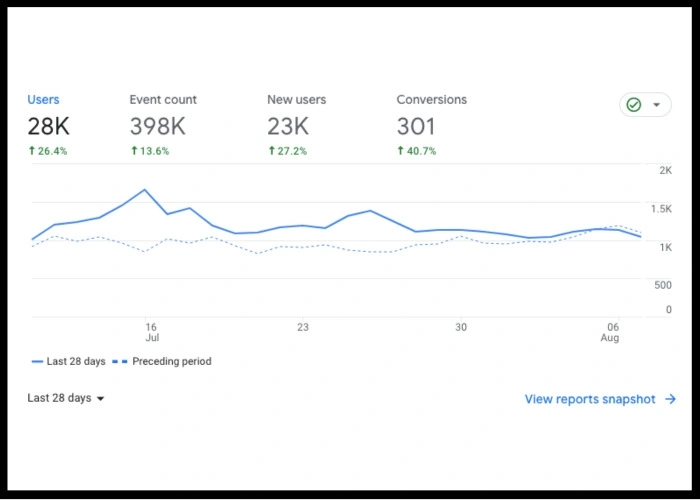
Understanding User Engagement Metrics:
User engagement metrics offer quantitative data on how users interact with a website. These indicators can highlight which content resonates, where visitors drop off, and the overall effectiveness of a website's design and content.
Why User Engagement Metrics Matter for Swimming Pool Companies:
- Spotlight on Quality: High engagement often means your content and website design resonate with visitors. It indicates you're addressing their needs and questions effectively.
- Retention and Loyalty: Engaged users are more likely to return, building a loyal customer base over time. They're also more likely to refer your services to others.
- Conversion Pathways: By understanding user engagement, you can optimize the paths that lead to conversions, be it a contact form submission, a brochure download, or an inquiry for a pool installation.
Key User Engagement Metrics for Pool Companies:
- Bounce Rate: Indicates the percentage of visitors who leave after viewing just one page. A high bounce rate might suggest that the landing page isn't meeting user expectations or isn't user-friendly.
- Average Session Duration - A visitor's average time on your site. Longer durations can indicate high-quality, engaging content.
- Pages Per Session: This shows the average number of pages a user visits in one session. This can help identify the most compelling content on your website.
- Click-Through Rate (CTR): Measures how often users click on a specific link compared to how many times that link is viewed (impressions).
- Returning vs. New Visitors: This ratio provides insights into loyalty and reach. A healthy mix of both is ideal for sustained business growth.
Boosting Engagement on Your Pool Website:
- Interactive Content: Incorporate quizzes, polls, or interactive galleries showcasing various pool designs and features to engage visitors.
- Clear Calls to Action (CTAs): Direct users with compelling CTAs. Whether it's to view a recent pool project, read customer testimonials, or contact for a quote, make the action you want them to take clear.
- Engaging Visuals: High-quality images, videos, and infographics can keep users on your site longer and encourage them to explore further.
Understanding and optimizing user engagement can set you apart in the competitive pool industry.
By paying attention to these metrics, swimming pool companies can refine their strategies, ensuring they're making the biggest splash in their digital pond.
Advanced On-Page SEO Techniques: Deep Diving Beyond the Basics
In the vast digital ocean, swimming pool companies mustn't just float; they must dive deep, exploring advanced on-page SEO techniques to stay ahead of the competition.
While basic SEO principles lay the groundwork, advanced strategies are like those intricate diving techniques that make a splash and leave the audience in awe.
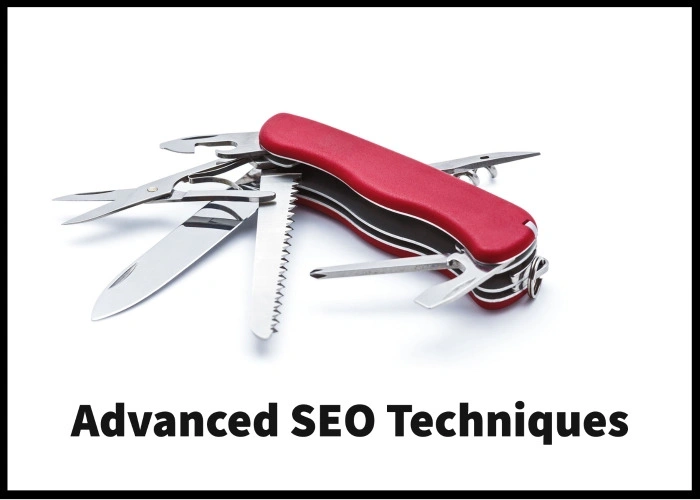
#1. Schema Markup: The Blueprint of Your Content
Understanding Schema Markup: Schema markup, often termed as 'structured data,' is a semantic vocabulary added to a website that helps search engines better understand the context of the content.
Why It's Essential for Pool Companies:
- Enhanced SERP Features: Schema can help your content appear in rich snippets, which are enhanced search results like reviews, ratings, or even a carousel of images.
- Increased Click-Through Rates: Rich snippets grab attention and can increase the likelihood of users clicking on your link.
Implementing Schema for Pool Companies:
- Use tools like Schema.org or Google's Structured Data Markup Helper for guidance.
- Implement pool-specific markups like product reviews, service ratings, or event markups for pool showcases.
#2. Latent Semantic Indexing (LSI) Keywords: The Undercurrents of Content
Decoding LSI Keywords:
LSI keywords are terms and phrases related to your main keyword. They provide context, helping search engines understand content depth and relevance.
Benefits for Swimming Pool Companies:
- Content Depth: Incorporating LSI keywords can make your content comprehensive, addressing various user queries.
- Avoiding Over-Optimization: LSI keywords reduce the risk of being penalized for keyword stuffing.
Using LSI Keywords Effectively:
- Tools like LSIGraph can help generate relevant LSI keywords.
- Integrate them naturally into your content, ensuring they enhance readability.
#3. Voice Search Optimization: Catering to the Modern User
The Rise of Voice Search:
With the proliferation of smart devices, voice search has seen exponential growth. Users are now asking Siri, Alexa, or Google Assistant about the best pool companies nearby.
Why Pool Companies Should Care:
- Staying Relevant: As more users adapt to voice search, companies must optimize for it to remain discoverable.
- Local SEO Boost: Voice searches are often local. "Pool companies near me" can direct potential customers to your doorstep.
Voice Search Optimization Tips:
- Focus on conversational keywords and phrases.
- Ensure your website's local SEO is spot-on, with an updated address, phone number, and services.
#4. Content Clusters: Creating Ecosystems of Knowledge
Grasping Content Clusters:
This involves creating a main pillar content piece and linking it to related subtopics. This interlinking creates a content web, establishing authority on a subject.
Significance for Pool Companies:
- Topic Authority: Search engines can recognize your website as an authority on pool-related topics, boosting overall domain strength.
- Improved User Experience: Users can navigate through interlinked content, finding all the information they need about a specific topic.
Building Content Clusters:
- Identify broad topics like "Infinity Pools" and create subtopics like "Infinity Pool Designs," "Maintenance of Infinity Pools," etc.
- Interlink these articles, ensuring seamless navigation.
Common Mistakes Pool Companies Make in On-Page SEO: Avoiding the Deep End
Dipping toes into the vast pool of SEO can be exhilarating. Still, for many swimming pool companies, unintentional missteps could lead to cold splashes of reality. Awareness is the lifeguard on duty; understanding common on-page SEO mistakes can pave the way for more confident strides in the digital domain.
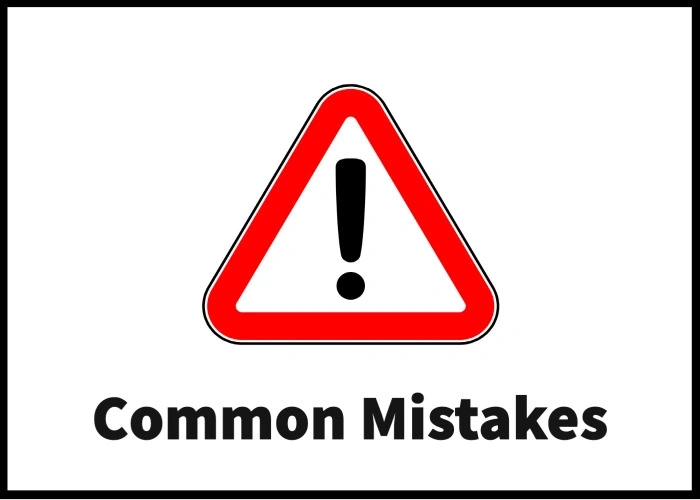
#1. Neglecting Quality Content: Depth Over Surface
The Oversight:
Prioritizing quantity over quality or stuffing keywords without adding real value.
Impact on Pool Companies:
- Loss of trust and authority in the industry.
- Penalization by search engines for low-quality content.
Pro Tip:
Always focus on creating in-depth, valuable content that addresses user intent. Research popular questions and provide comprehensive answers.
#2. Overlooking Image Optimization: A Picture Speaks a Thousand Keywords
The Blunder:
Uploading heavy images without alt text or descriptive file names.
Consequences for Swimming Pool Companies:
- Slower page load times lead to poor user experience.
- Missing out on potential image search traffic.
Quick Fix:
Always compress images before uploading and use descriptive file names and alt tags.
#3. Ignoring Mobile Optimization: The Pocket-Sized Pool
The Slip:
Having a website that's not mobile-friendly.
Why It Hurts Pool Companies:
- A significant number of users browse on mobile. A non-optimized site alienates this audience.
- Google uses mobile-first indexing, which means non-optimized sites suffer in rankings.
Action Step:
Ensure your website design is responsive and undergoes regular mobile usability tests.
#4. Forgetting About Meta Descriptions: The Welcome Mat
The Oversight:
Not crafting compelling, keyword-optimized meta descriptions.
Impact on Pool Companies:
- Lower click-through rates from search engine results.
- Missed opportunity to pitch content to potential visitors.
Guideline:
Write enticing meta descriptions, incorporating main keywords and keeping within the recommended character limit.
#5. Over-Complex URL Structures: The Twisted Path
The Error:
Using lengthy, non-descriptive, or numeric-heavy URLs.
Why It's Problematic for Pool Companies:
- Confuses both search engines and users.
- Missed opportunities for keyword optimization.
Recommendation:
Keep URLs concise, descriptive, and free from unnecessary special characters or numbers.
#6. Not Utilizing Internal Linking: The Pool Ladder
The Miss:
Not linking to relevant content within your website.
Challenges for Pool Companies:
- Reduces the chance for users to explore more of your content.
- Missed opportunities for boosting page authority.
Guideline:
Always look for opportunities to link to your site's related articles, services, or product pages.
Tools and Resources for On-Page SEO: Dive Deeper into Digital Success
Navigating the vast waters of on-page SEO can be challenging for swimming pool companies. But with the right set of goggles, you can see clearly and swim confidently. Here's a curated collection of tools and resources tailored to amplify your on-page SEO efforts.
Keyword Research Tools: Unearth Golden Keywords
a. Google Keyword Planner:
- What It Does: Offers keyword ideas and search volume data based on Google's vast database.
- Why Pool Companies Should Use It: Identify potential customers' terms when looking for pool services or products.
b. Ubersuggest:
- What It Does: Provides keyword suggestions, competition data, and seasonal trends.
- Why It's Valuable: Understand what keywords competitors might target and find hidden gems.
Content Optimization: Making Every Word Count
a. Yoast SEO (WordPress plugin):
- Function: Evaluates on-page SEO elements and provides actionable feedback.
- Benefits for Pool Companies: Ensures every blog post or page meets basic SEO standards before publishing.
b. Clearscope:
- Function: Analyzes top-ranking content and offers insights to improve content depth and relevance.
- Advantage: Increase content quality by matching or surpassing competitor depth.
Mobile-Friendly Testing: Ensure Seamless Experiences
a. Google's Mobile-Friendly Test:
- What It Offers: A snapshot of how Google views your site on mobile and suggestions for improvement.
- Why It's Essential: Validate your website's mobile usability and stay in Google's graces.
Speed and Performance Testers: Don't Keep Users Waiting
a. GTMetrix:
- Role: Measures website speed and offers detailed insights on areas of improvement.
- Benefits for Pool Companies: Faster websites improve user experience and boost SEO rankings.
b. Google PageSpeed Insights:
- Role: Analyzes webpage content and offers suggestions to make the page faster.
- Perks: Implement Google-recommended changes for better user experience and potential SEO benefits.
On-Page SEO Analyzers: Perfecting Every Element
a. SEMrush On-Page SEO Checker:
- Features: Analyzes on-page elements, checks content quality, and offers optimization recommendations.
- Significance: Provides a comprehensive report to fine-tune pages for optimal performance.
b. Screaming Frog SEO Spider:
- Features: A desktop program that crawls websites and fetches key on-page elements for analysis.
- Why It's Handy: Swiftly identifies issues like broken links, duplicate content, and missing metadata.
Conclusion and Next Steps: Dive into a Brighter Digital Future
On-page SEO stands as a beacon in the vast digital ocean. Understanding its depths can be the key to a powerful online presence for swimming pool companies. It's more than ticking boxes; crafting experiences, narrating stories, and cultivating trust.

Next Steps to Propel Your Pool Company Forward:
- Audit Your Current On-Page SEO: Evaluate where you currently stand before optimizing. Tools like SEMrush or Screaming Frog can comprehensively view your strengths and areas needing attention.
- Stay Updated: SEO isn't static. Search engine algorithms change, and user behavior evolves. Dedicate time to learn about the latest trends and updates, ensuring your tactics remain effective.
- Engage with Professionals: Consider collaborating with SEO specialists or digital marketing agencies that can bring expertise and an external perspective to your strategy.
- Monitor and Analyze: The power of analytics cannot be overstated. Tools like Google Analytics can provide insights into user behavior on your website. Monitor these metrics to understand the impact of your SEO strategies and make necessary tweaks.
- Educate Your Team: SEO is a collective effort. Ensure everyone, from content creators to designers, understands the basics and the importance of on-page SEO.
- Solicit Feedback: Reach out to peers, customers, or industry experts for feedback on your website's user experience. Sometimes, an external perspective can spotlight overlooked issues or opportunities.
The digital pool is vast and deep, but with on-page SEO for swimming pool companies, swimming pool companies, you can ride the currents to success.
Are you ready do start doing on-page SEO?

About the author
With over half a decade of hands-on experience, I've honed my skills to become an SEO specialist. My passion for increasing my client's online visibility and cash flow, matches my clients' drive to create the best swimming pools. Leveraging cutting-edge SEO strategies, I've catapulted businesses to the top of search engine results, leading to increased leads, conversions, and revenue.
